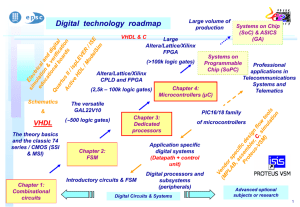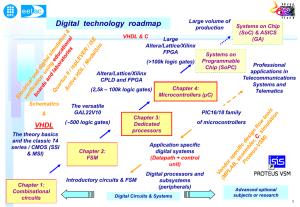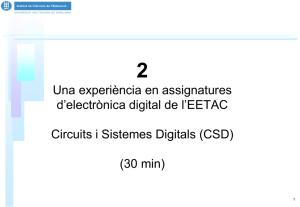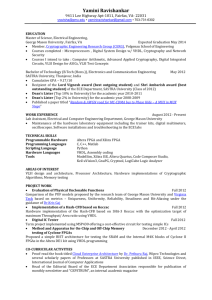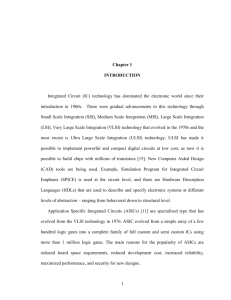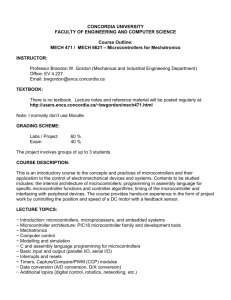presentation
advertisement
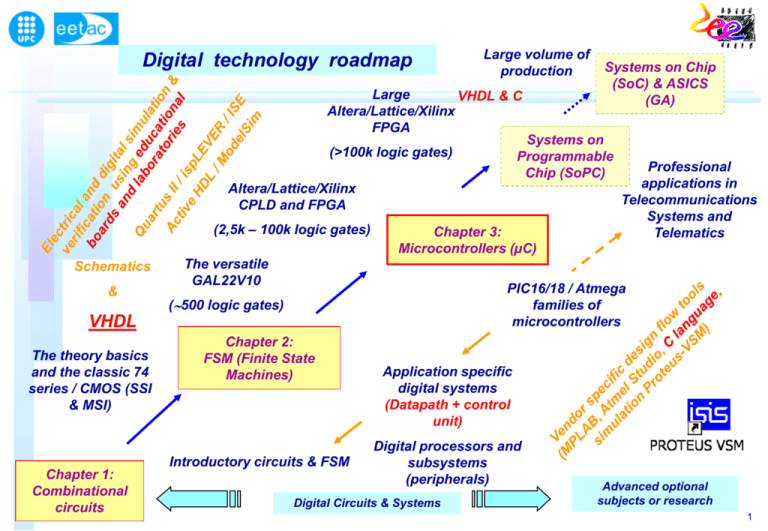
Digital technology roadmap Large volume of production Large VHDL & C Altera/Lattice/Xilinx FPGA Systems on Programmable Chip (SoPC) (>100k logic gates) Altera/Lattice/Xilinx CPLD and FPGA (2,5k – 100k logic gates) Schematics & Chapter 3: Microcontrollers (µC) The versatile GAL22V10 (500 logic gates) Chapter 2: FSM (Finite State Machines) Introductory circuits & FSM Chapter 1: Combinational circuits Professional applications in Telecommunications Systems and Telematics PIC16/18 / Atmega families of microcontrollers VHDL The theory basics and the classic 74 series / CMOS (SSI & MSI) Systems on Chip (SoC) & ASICS (GA) Application specific digital systems (Datapath + control unit) Digital processors and subsystems (peripherals) Digital Circuits & Systems Advanced optional subjects or research 1 CSD competencies /learning goals Programmable logic devices and VHDL Microcontrollers English Self-directed learning Oral and written communication Project management Team work Lab skills (Systematically design, analyse, simulate, implement, measure, report, present, publish on the web and reflect about … digital circuits and systems using state-of-the-art digital programmable devices, CAD/EDA software tools and laboratory equipment And show all your achievements constructing your ePortfolio 2 CSD systematic instructional design Learning objectives and cross-curricular skills After completing the course students have to be able to … Repeated every term Course evaluation Student questionnaires, and instructors processing Coherence and consistency Continuous formative and summative assessment Activities and study time scheduling In and out of class timetable, problembased learning, application project Systematic procedures for solving assignments (plan, develop, simulate, prototype, measure, report) Active methodologies Individual and group assessing, group eportfolio No need of traditional exams Cooperative Learning, integrated learning of content and cross-curricular skills, Learning by doing 3 CSD specific content Chapter 1 Chapter 2 Chapter 3 Combinational circuits Finite state machines Microcontrollers (50 h) – 2 ECTS (FSM) (50 h) – 2 ECTS (C) (50h) – 2 ECTS Laboratory skills: logic analysers, debuggers/programmers, simulators, etc. … •Proteus-ISIS (Labcenter) •Quartus II (Altera) •Proteus-VSM (Labcenter) •Minilog, IC prog •ispLEVER Starter or Classic (Lattice Semiconductor) •WolframAlpha •ISE (Xilinx) •MPLAB (Microchip) / Atmel Studio •C compilers •VHDL •ModelSim (Mentor Graphics), •Active HDL (Aldec) •ISim (Xilinx) •Synplicity Synplify synthesis (Synopsys) • Altera Integrated Synthesis • XST (Xilinx Synthesis tools) •Classic IC’s • sPLD GAL22V10 •ispLEVER Classic • Programmable logic devices (CPLD and FPGA) from Altera, Lattice, Xilinx •Training boards (UP2, DE2, Spartan 3AN Starter Kit, MachXO USB Starter Kit, NEXYS 2, etc. • PIC 16F/18F family of microcontrollers , Atmel microcontrollers • Training boards PICDEM2+, etc. 4 CSD generic tools Oral and written communication English Self-directed learning Team work Project management •Microsoft Office • Google docs • Visio 2010 • Google sites •Thunderbird • Web editing tools •CMapTools • Proofing tools •Gantt diagrams • Google translate • etc. 5 Planning activities and study time in and out of the classroom (6 ECTS – 150 h) Weekly study plan Activities (~problem solving all the time) (P1 .. P12) Oral presentation Guided learning Exercises Individual test Problem solving teamwork session at classroom (2 h) (tutorials) Problem solving teamwork session at laboratory (2 h) Problem solving teamwork session and assessment at laboratory (1 h)* 12 weeks 12.5 h per week (IT1, IT2, IT3) Self-directed learning ePortfolio Student-conducted teamwork sessions 6 ECTS (>6h) Extra individual work * Guided academic activities 6 Web pages and blog 7 Activities Design of real world applications Design using PLD/VHDL Design using microcontrollers 8 The content on the CSD web (units) is focused on problem solving 9 Cooperative Learning as the instructional method • Positive interdependence Team members are obliged to rely on one another to achieve their common goal • Individual accountability All students in a group are held accountable for doing their share of the work and for mastery of all of the content to be learned • Face-to-face promotive interaction Group members providing one another with feedback, challenging one another’s conclusions and reasoning, and teaching and encouraging one another • Appropriate use of collaborative skills Students are encouraged and helped to develop and practice skills in communication, leadership, decision-making, conflict management, and other aspects of effective teamwork • Regular self-assessment of group functioning Team members periodically assess what they are doing well as a team and what 10 they need to work on for functioning more effectively in the future A typical 2-hour group work session Up to 15 minutes Questions from previous sessions or exercises Up to 15 minutes Introduction of new concepts or materials (generally, the problem to be designed) 30 minutes Group work for revising concepts and planning exercises Up to 15 minutes Questions, discussion and general orientations 30 minutes Group work for developing exercises 15 minutes Conclusions and planning for the studentdirected sessions outside the classroom 11 Cooperative group ePortfolio and instructor’s feedback A semi structured group e-portfolio organised to show your learning process and results 12 Student assessment Assessment is not a mechanism for verifying student knowledge, but an stimulus to guarantee that (motivated) students will do the group tasks which lead them to learn the content and skills Assessment is another learning activity integrated in the course dynamics ePortfolio Every piece of work counts for the final grade • Final exams are no longer needed 13 Assessment scheme Rubrics and examples from previous terms, facilitates assessing and classroom dynamics gives fast feedback Projects + Cooperative group projects every week or every two weeks An group oral presentation of a course exercise Individual test + 3 individual exams Examples to demonstrate content learning, crosscurricular skills development and reflection Oral Presentation + e-Portfolio + Participation If failed downgrade project marks Ep1: Week 6, 4% and attitude Ep2: Week 12 , 8% Q P 48% IT 24% Oral _ P 10% eP 12% P & A 6% Continuous assessment: you’ll always know where you are and what you have to do to get better marks 14 Assessment scheme A remark on the projects assessment: There is a link between the IT and the weekly projects: Projects (48%) Individual Test (24%) P1 .. P4 IT1 P5 .. P8 IT2 P9 .. P12 IT3 Projects will have a provisional group grade. In order to consolidate it, students have to pass the corresponding IT. If a student fails the IT, the corresponding projects will be downgraded to “4”. At the exams weeks there will be another opportunity to pass or improve IT1 (week 7) and IT2 and IT3 (week 14). 15 Course evaluation and processing This quality cycle has to be repeated every term CSD WEB page Course evaluation Student questionnaires, and instructors processing Learning objectives and cross-curricular skills Coherence and consistency Continuous formative and summative assessment Activities and study time scheduling Active methodologies The evaluation’s aim is to prepare a plan with specific actions to improve teaching in upcoming courses (problems redesigning, timetable scheduling, workload, teaching materials, new software, demonstration exercises, etc.). Examples of feedback (http://digsys.upc.es/ed/CSD/feedback/CSDfdbk.html) . 16
